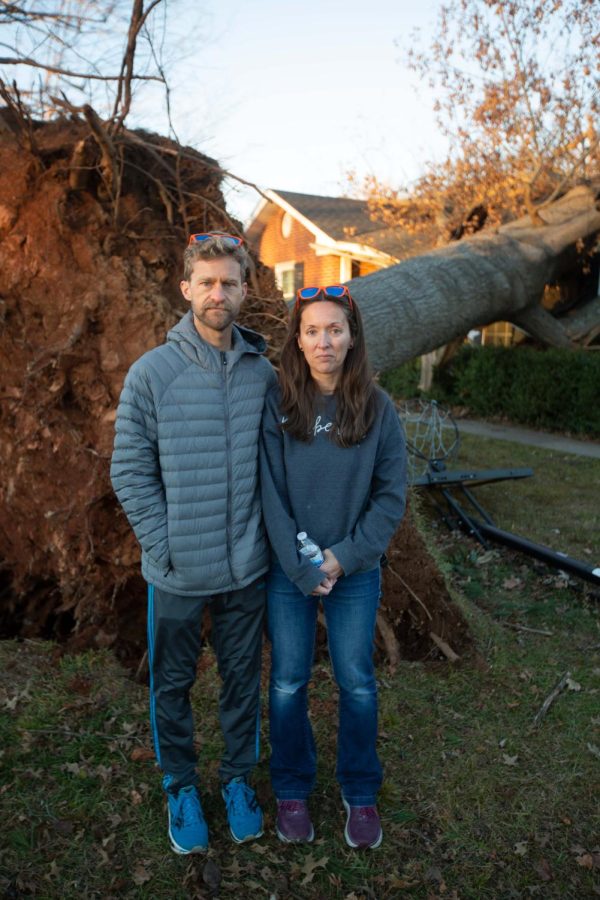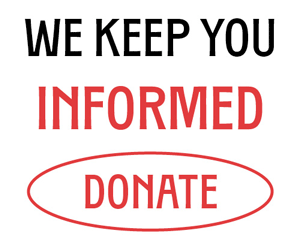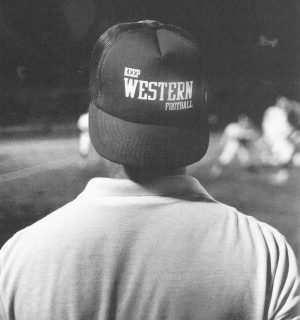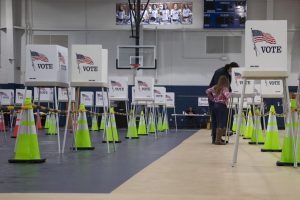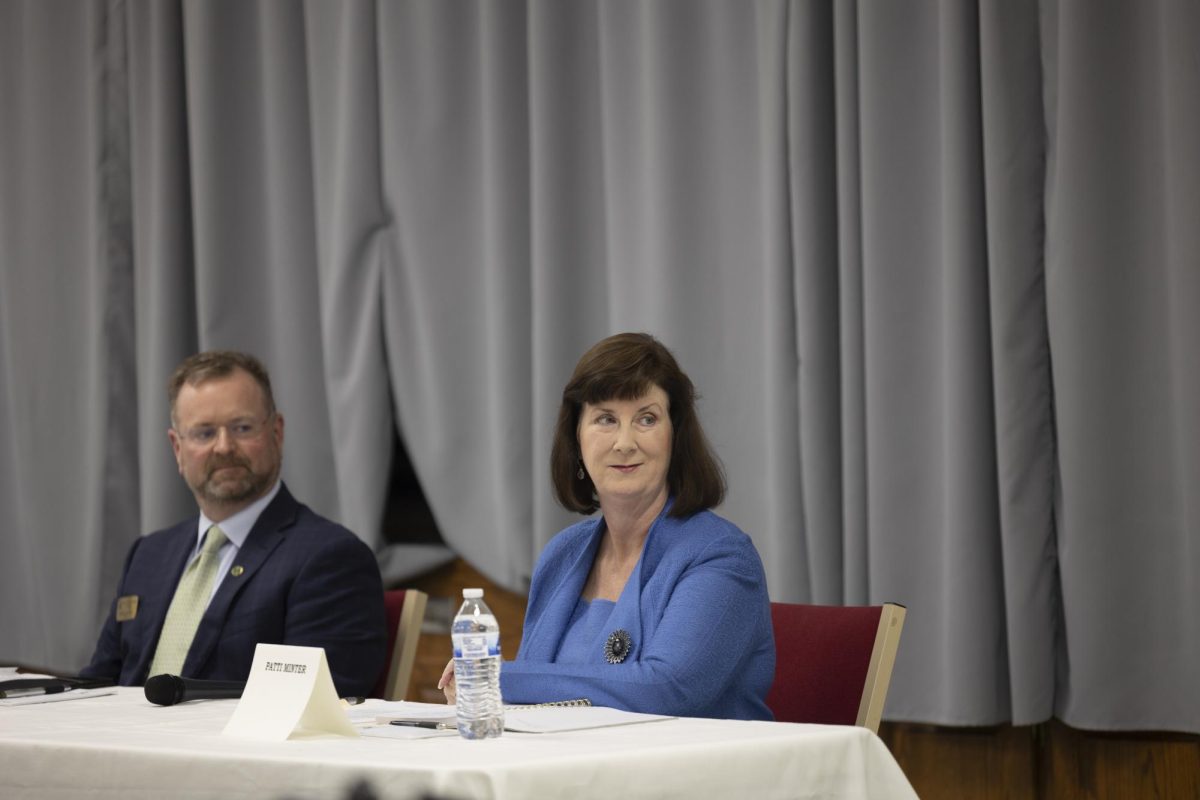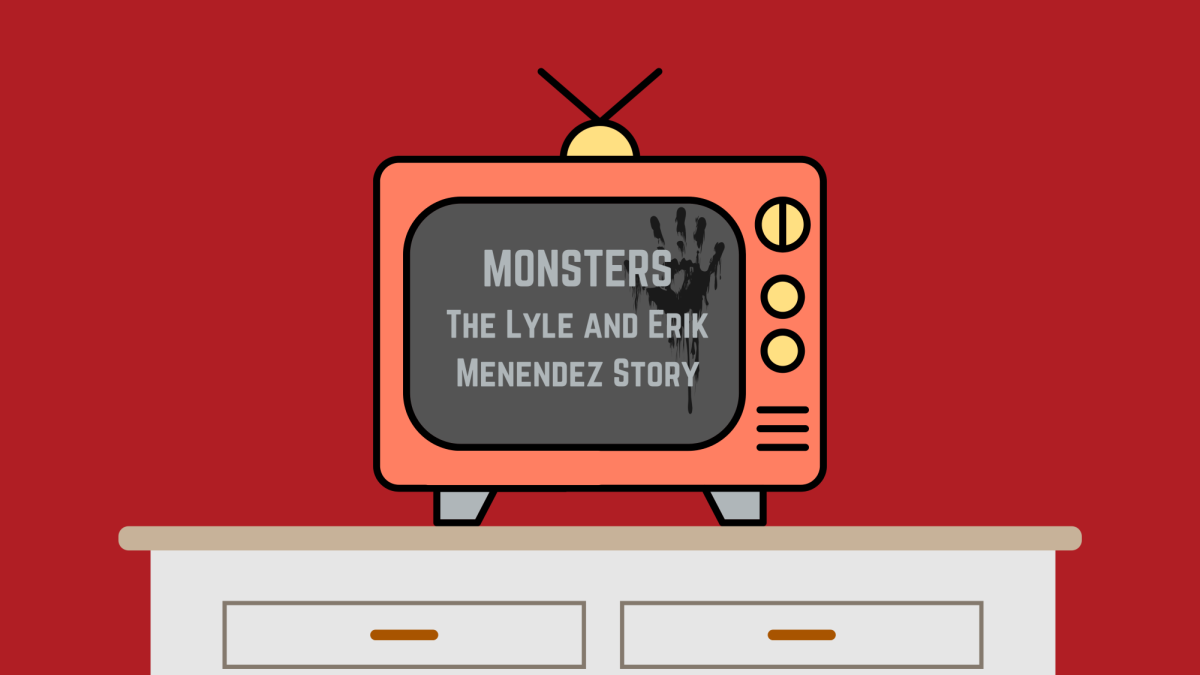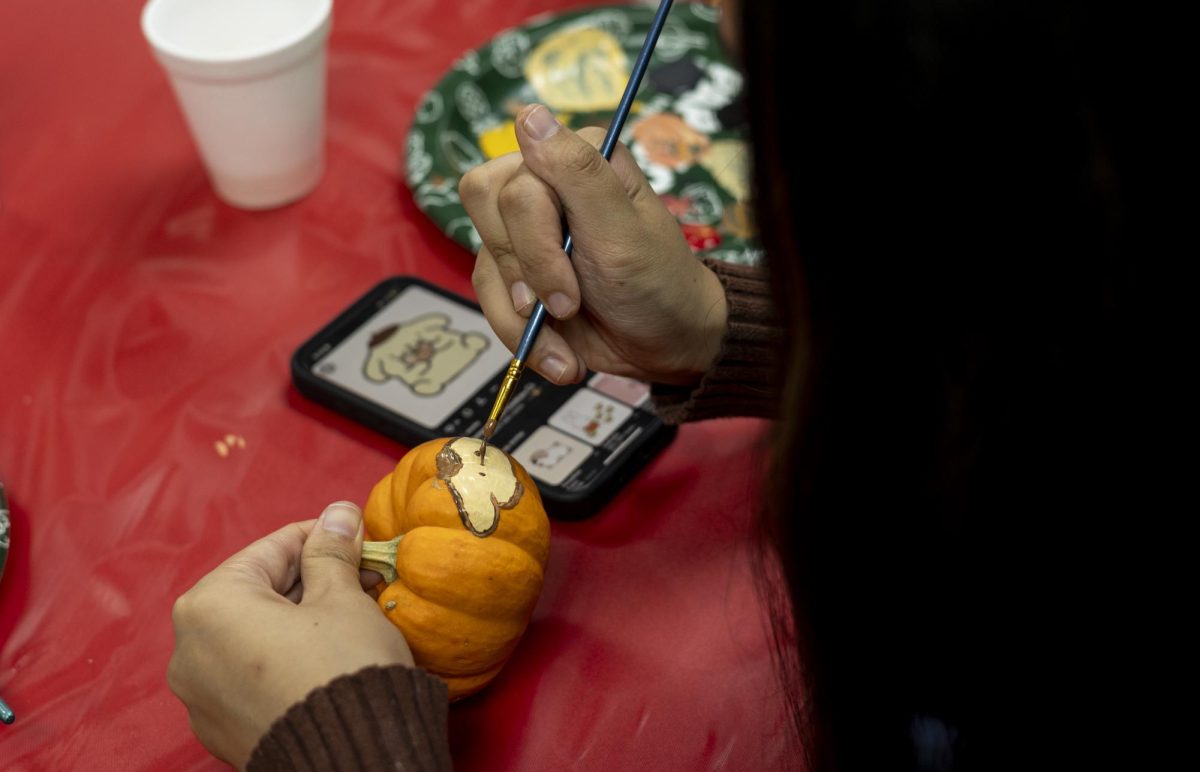‘Did this just happen to me?’: WKU community members lose everything, escape with their lives
Cort and Laurie Basham stand in front of the tree that fell on their home the day before. “The stuff that really affects me is the unbelievable response from our community,” Basham said.
January 18, 2022
At 1:27 a.m. the screeching sound of alarms shook the Basham family awake. The National Weather Service had issued a tornado warning for Bowling Green –and the family’s lives were about to be uprooted.
“The phones woke us up with an alert,” Cort Basham, a 25-year resident of Bowling Green and associate professor of pedagogical studies at WKU, said. “[We] got in the closet — even got the dog — with my two kids.”
What was initially thought to be one tornado is now believed to be three separate tornadoes according to the National Weather Service. These prompted tornado sirens and emergency alert warnings just after 1 a.m.
“About 1:45 a.m, I was watching the radar and knew it was going to be close,” Basham said. “I’ve been through one tornado before, so when I felt the pressure in the house change — my ears popped, then you heard the train noise everyone talks about when you hear tornadoes — I knew at that point what it was.”
The Bashams heard a tremendous crash: a massive tree that stood in their front yard had fallen on their house. Basham saw his daughter jolt forward when they realized that a large branch had come through the wall of the closet they were in.

“Everyone started screaming,” Basham said. “We opened the door and there’s a tree branch through the roof, through the ceiling into our bed, which is eight feet away.”
The next few minutes were a blur, but Basham said he could sense his family was in serious danger and needed to get to the back door. Basham’s wife Laurie, scholarship coordinator at the College Heights Foundation, said they exited the closet, turning left into their family room, then walking under the tree that was on top of their house before arriving in the kitchen.
“At that point we were breathing in insulation and it’s pure chaos,” Basham said. “We opened the back door and there’s trees on both sides — no way to go. I tried to go left towards the patio and there’s really no way to go. My son figured out if you just turned the corner of the house and stayed near the house you could kind of skirt the tree.”
They trekked through total darkness for several blocks, passing over at least 12 fallen power lines before safely arriving at the home they’d stay in for the night, guided only by an iPhone light, according to Basham.
“On the face, emotionally, my daughter is having a pretty hard time with it,” Basham said. “Just realizing we’re not going to go back there — we’re not going to go back home, at least not for a while, — and that home won’t be the same, most likely.”
The thing that stood out the most is the outreach and support they’ve received from their community, Basham said.
“The stuff that really affects me is the unbelievable response from our community,” Basham said. “The offers we have — there’s 30 houses we could drive to right now, stay, and we would be fine. When we’re living our lives in the 21st century, it’s sometimes hard for that to come through all the time, and [the support] has been so constant and immediate right now.”
The Basham family is not the only member of the WKU community who has been affected by this tragedy.
Kate Hudepohl, an anthropologist in the folk studies department at WKU and 18-year resident of the Bowling Green community, lived a few houses down from the Bashams and also had her house destroyed by the tornadoes.
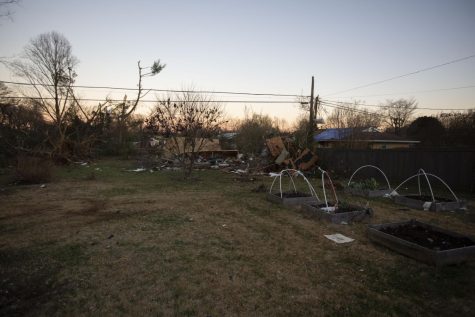
“I got my closet in my hallway ready, but I still thought probably it’s okay, but I continued to put supplies in front of it,” Hudepohl said. Hudepohl set her alarm for 2:30 a.m., when it was reported the storms would likely be in Bowling Green, and then fell asleep in her living room watching the news.
“I woke up for whatever reason like at 1 o’clock to the news reporting on WBKO that there was a radar indicating a likely tornado,” Hudepohl said. “I just leapt up, ran to my closet, and grabbed one of my cats I saw. I put a cushion over our head from the living room couch and stayed there. It came right over my house.”
The living room that Hudepohl was asleep in was destroyed. Both of her cats survived. While her life has been completely turned upside down, Hudepohl is thankful for the support she’s received from her community.
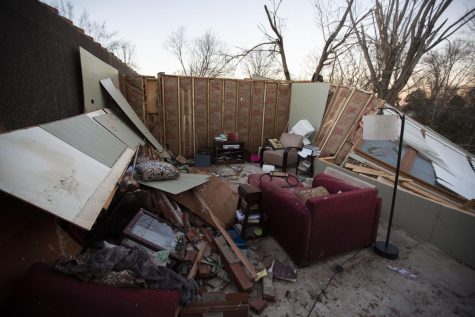
“My heart is full,” Hudepohl said. “I was working here with my parents earlier, and these community members showed up with heavy duty equipment and chainsaws and backhoes. All these piles of rubble at the curb they moved.”
Angie Link, the office coordinator for ISEC at WKU and a Bowling Green resident for 25 years, lives on Meadowbrook Circle and lost everything in the storm. Her husband was watching the storm from the front door when the roof began to collapse, and he ran to the master bedroom as the front part of the house fell.
“I guess he forgot I was in the restroom,” Link said. “I was afraid to look up but I could see his feet. He came through here and glass was hitting him and he was barefooted.”
He moved past the bathroom, making his way into the master bedroom, eventually seeking refuge in the master bathroom.
“I don’t say I heard the freight train sound, I guess I dazed out,” Link said. “The only thing I really heard I remember is my house caving in, I heard it crumbling.”
Only three rooms in the house remain relatively untouched, including her master bedroom, her daughter’s room and the living room.
“You don’t expect anything like this to happen,” Link said. “It was quick, it was powerful, and you’re just saying, ‘Did this just happen to me?’ You’re scared, you’re shaking, you’re praying. I’m screaming and crying just saying ‘Jesus, Jesus, Jesus, Jesus.’ My husband is running down the hallway screaming ‘Jesus, Jesus, Jesus.’ It is surreal.”

Like many who have experienced damage, Link has been overwhelmed with community outreach and the support she’s received.
“We have people coming from different places here in the community — don’t know them, never seen them — Bowling Green is the best,” Link said. “If you need something to wear, something to eat, they’re there for you. Everyone has just been so good.”
Link’s entire neighborhood was destroyed, and she said what is getting her through the toughest of it is her faith.
“Jesus is good,” Link said. “He has sustained all of us through this situation. You know, I keep thinking about him, my husband is running for his life down the hallway and he escaped. It’s amazing.”
Since the tornado, thousands of volunteers and workers have flooded the Bowling Green community, many from outside the Commonwealth of Kentucky.
Clay Mullins, the global impact pastor at Living Hope Baptist Church in Bowling Green, was tasked with coordinating the flood of volunteers from around the county and said that the outpouring is unlike anything he has experienced.
“It’s been incredible,” Mullins said. “We’re still putting the final numbers in, but by the end of last week we were just shy of 4,000 people that we’ve coordinated. The whole nation has had their eye on Bowling Green and offered to help.”
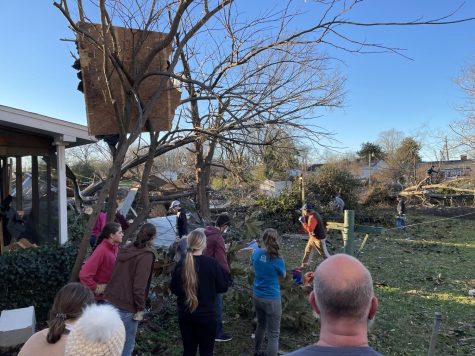
Immediately following the tornado, the church began to organize their efforts around one simple mission: creating pathways for people to get back to their homes and vehicles.
“The city manager is a member of our church and I sent him a message asking him where best for us to begin sending our teams,” Mullins said. “That Sunday, we sent out about 300 people in 27 teams just from our church. We rallied our teams around the idea of helping to create a little order in the chaos to where the authorities could then come in and do their work.”
Mullins has coordinated the majority of volunteer efforts and has been out in the community. Operations were turned back over to the city during the second week of January. He spoke to several survivors early on and noted the undertones of their conversations.
“There was an old saying about the Vietnam Veterans, that some would come home with a 1,000-yard stare, and it seemed like there was a bit of that [talking with survivors],” Mullins said. “When you would have a conversation with someone, they would be with you in the conversation verbally, but their eyes were elsewhere. You could tell their minds were divided. The word ‘trauma’ doesn’t do justice to what I’ve observed some people experiencing.”
With the amount of trauma the community has seen, Mullins said it’s important for people to remember that they are not alone, and there is still healing to be done.
“I know there are counseling services all over,” Mullins said. “You have the Hope Center for Biblical Counseling that is there gearing up to provide free counseling services to anyone that needs to talk through this. They’re putting together support groups and individual counseling to help people as they deal with the aftermath from this.”
Mullins said serving in his community after the storm has been one of the most meaningful experiences of his life. “I have been amazed at the city that we live in, and the people of this city and how they have rallied around those who have been so deeply affected,” Mullins said. “I am so proud to be a part of a city of this caliber.”
In addition to the Hope Center, counseling services are available in the same facility as FEMA in the Sears wing of the mall, free of charge provided by LifeSkills of Bowling Green. They can also be reached at 270-901-5000 if individuals need to schedule in-person or telehealth visits according to their office.
Michael Dylan Payne can be reached at [email protected]. Follow him on Twitter @mdpayne_.

